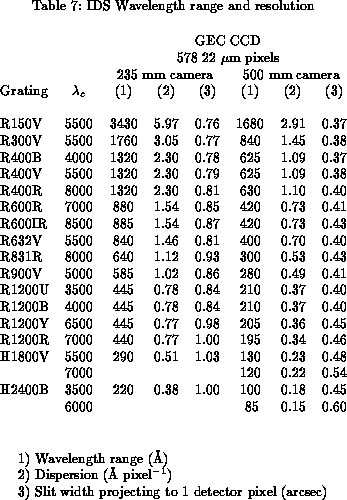





Previous: Performance
Up: Performance
Next: Throughput
Previous Page: Performance
Next Page: Throughput






Previous: Performance
Up: Performance
Next: Throughput
Previous Page: Performance
Next Page: Throughput
Table 3.4 summarises the wavelength
range and resolution for the IDS gratings using a coated
GEC CCD and either the 235 mm or the 500 mm cameras. With the exception of
the 1800 and 2400
lines mm gratings, the wavelength coverage does not significantly
vary with the central wavelength.
gratings, the wavelength coverage does not significantly
vary with the central wavelength.
The tables give for each configuration the wavelength range, the
dispersion in Å pixel , and the slit width projecting
to one pixel at the detector. For proper sampling, the wavelength
resolution cannot be less than about 2 pixels. To match the slit to the
resolution ot the spectrograph, a slit width should
be used which projects to about 2 pixels at the detector. If a
wider slit is used to increase the total light collected by the instrument,
this will degrade the wavelength resolution. This might be a good strategy
in bad seeing conditions or for extended objects.
, and the slit width projecting
to one pixel at the detector. For proper sampling, the wavelength
resolution cannot be less than about 2 pixels. To match the slit to the
resolution ot the spectrograph, a slit width should
be used which projects to about 2 pixels at the detector. If a
wider slit is used to increase the total light collected by the instrument,
this will degrade the wavelength resolution. This might be a good strategy
in bad seeing conditions or for extended objects.
One point worth noting is that if a grating were to be mounted with the wrong orientation, (i.e. the blaze directed towards the other camera) it would result in a dramatic decrease of throughput. The dispersion will be affected too, and, in fact, a resolution improvement of about 20 can be obtained at high anamorphic magnification, but only at the cost of a drastic loss of efficiency (see J.V. Wall 1984, Gemini 12).
